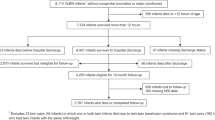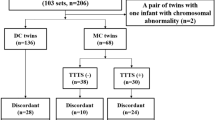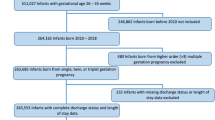Abstract
Objective:
To compare neonatal morbidity and mortality between hospitalized discordant and concordant preterm twin pairs.
Study Design:
This was a retrospective, hospital-based study of preterm twins, followed in neonatal intensive care unit. Twins were classified as discordant when the difference in birth weight was >15%. Morbidity and mortality rates were compared between discordant and concordant groups.
Results:
Of 136 preterm twins in the study, 54 were discordant and 82 were concordant. In discordant twins hypoglycemia and cesarean delivery rate was higher than concordant pairs. The mortality rate did not differ between concordant and discordant groups.
Conclusions:
Hospitalized preterm discordant twin pairs have an increased risk of hypoglycemia compared to concordants. Discordant growth is not a risk factor for prolonged hospitalization and increased mortality.
This is a preview of subscription content, access via your institution
Access options
Subscribe to this journal
Receive 12 print issues and online access
$259.00 per year
only $21.58 per issue
Buy this article
- Purchase on Springer Link
- Instant access to full article PDF
Prices may be subject to local taxes which are calculated during checkout
Similar content being viewed by others
References
Martin JA, Hamilton BA, Venture SJ, Menacker F, Park MM, Sutton PD . Births: final data for 2001. Natl Vital Stat Rep 2002; 51: 1–102.
Baker ER, Beach ML, Craigo SD, Harvey-Wilkes KB, D'Alton ME . A comparison of neonatal outcomes of age matched, growth-restricted twins and growth-restricted singletons. Am J Perinat 1997; 14: 499–502.
Blickstein I, Shoham-Schwartz Z, Lancet M, Borenstein R . Characterization of the growth-discordant twin. Obstet Gynecol 1987; 70: 11–15.
Price B . Primary biases in twin studies. A review of prenatal and natal difference producing factors in monozygotic pairs. Am J Hum Genet 1950; 2: 294.
Talbot GT, Goldstein RF, Nesbitt T et al. Is size discordancy an indication for delivery of preterm twins? Am J Obstet Gynecol 1997; 177: 1050–1054.
Cheung VYT, Bocking ADB, Dasilva OP . Preterm discordant twins: what birth weight difference is significant? Am J Obstet Gynecol 1995; 172: 955–959.
Sonntag J, Waltz S, Schollmeyer T et al. Morbidity and mortality of discordant twins up to 34 weeks of gestational age. Eur J Pediatr 1996; 155: 224–229.
Kato N . Reference birth weight range for multiple birth neonates in Japan. BMC Pregnancy and Childbirth 2004; 4: 1–9.
Ballard JL, Novak KK, Driver M . Simplified score for assessment of fetal maturation of newly born infants. J Pediatr 1979; 95: 769–774.
Kleigman RM, Walker WA, Yolken RH . Necrotising enterocolitis: research agenda for a disease of unknown etiology and pathogenesis. Pediatr Res 1993; 34: 701–708.
Blanchette V, Doyle J, Schmidt B, Zipursky A . Heamotology In: Avery GB, Fletcher MA, Macdonald MG (eds). JB Lippincott Company: Philadelphia (4th edn.), 1994; 953.
Töllner U . Early diagnosis of septicemia in the newborn. Clinical studies and sepsis score. Eur J Pediatr 1982; 138: 331–337.
Blickstein I . The definition, diagnosis, and management of growth-discordant twins: an international census survey. Acta Genet Med Gemellol 1991; 40: 345–351.
Blickstein I, Lancet M . The growth discordant twin. Obstet Gynecol Surv 1988; 43: 509–515.
Erkkola R, Ala-Mello S, Piiroinen O, Kero P et al. Growth discordancy in twin pregnancies: A risk factor not detected by measurement of biparietal diameter. Obstet Gynecol 1985; 66: 203–206.
Cooperstock MS, Tummaru R, Bakewell J, Schramm W . Twin birth weight discordance and risk of preterm birth. Am J Obstet Gynecol 2000; 183: 63–67.
Demissie K, Ananth CV, Martin J et al. Fetal and neonatal mortality among twin gestations in the United States: The role of intrapair birth weight discordance. Obstet Gynecol 2002; 100: 474–480.
Hsieh TT, Chang TC, Chiu TH, Hsu JJ, Chao A . Growth discordancy, birth weight, and neonatal adverse events in third trimester twin gestations. Gynecol Obstet Invest 1994; 38: 36–40.
Wen SW, Fung KF, Huang L et al. Fetal and neonatal mortality among twin gestations in a Canadian population: the effect of intrapair birthweight discordance. Am J Perinatol 2005; 22: 279–286.
Blickstein I, Shoham-Schwartz Z, Lancet M . Growth discordancy in appropiate for gestational age, term twins. Obstet Gynecol 1988; 72: 582–584.
Yinon Y, Mazkereth R, Rosentzweig N et al. Growth restriction as a determinant of outcome in preterm discordant twins. Obstet Gynecol 2005; 105: 80–84.
Patterson RM, Wood RC . What is twin birth weight discordance? Am J Perinatol 1990; 7: 217–219.
Amaru RC, Bush MC, Berkowitz RL, Lapinski RH, Gaddipati S . Is discordant growth in twins an independent risk factor for adverse neonatal outcome? Obstet Gynecol 2004; 103: 71–76.
Nassar HN, Usta IM, Khalil AM, Aswad NA, Seoud MAF . Neonatal outcome of growth discordant twin gestations. J Perinat Med 2003; 31: 330–336.
Gonzalez-Quintero V, Luke B, O'Sullivan MJ, Misiunas R, Anderson E . Antenatal factors associated with significant birth weight discordancy in twin gestations. Am J Obstet Gynecol 2003; 189: 813–817.
Author information
Authors and Affiliations
Corresponding author
Rights and permissions
About this article
Cite this article
Kilic, M., Aygun, C., Kaynar-Tunçel, E. et al. Does birth weight discordance in preterm twins affect neonatal outcome?. J Perinatol 26, 268–272 (2006). https://doi.org/10.1038/sj.jp.7211495
Received:
Revised:
Accepted:
Published:
Issue Date:
DOI: https://doi.org/10.1038/sj.jp.7211495
Keywords
This article is cited by
-
Assessment of different thresholds of birthweight discordance for early neonatal outcomes: retrospective analysis of 2348 twin pregnancies
BMC Pregnancy and Childbirth (2022)
-
Birth weight discordance in very low birth weight twins: mortality, morbidity, and neurodevelopment
Journal of Perinatology (2019)



